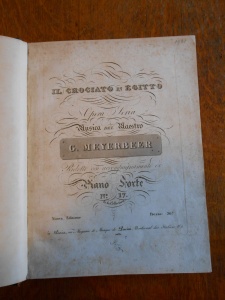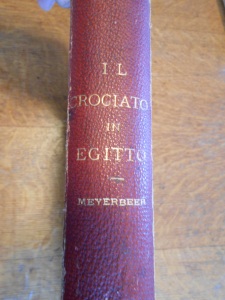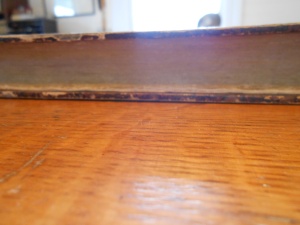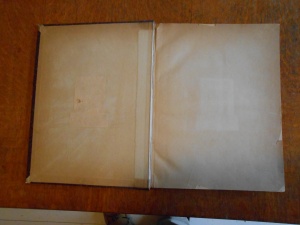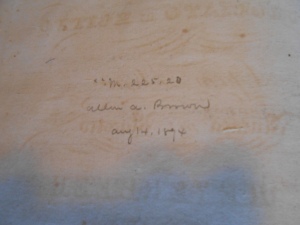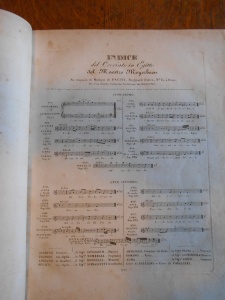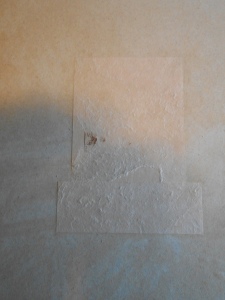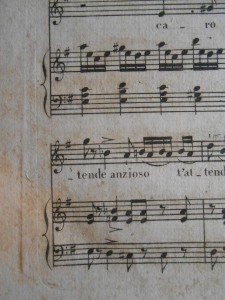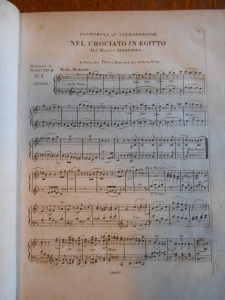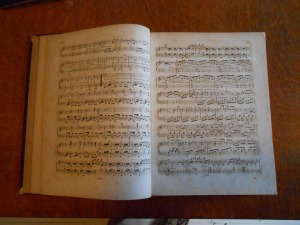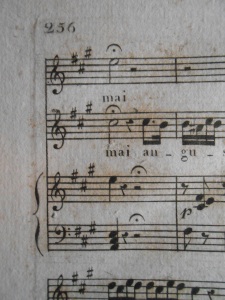This is a mystery about an original copy of the 1829 opera score by Meyerbeer: how it disappeared from one of American’s premier library collections and ended up in North Carolina.
The book is an original score that reads:
Il Crociato in Egitto
Opera Seria Musica del Maestro
G. Meyerbeer
Ridotto con accompagnamento di
Piano Forte
No. 17
de la Collection
Novoa Edizione Prezzo: 36f
a Parie, au Magasin de Musique de Pacini Boulevard des Italiens, No 11
During the late 1980s, while living in Boston’s North Shore, I visited used book stores with an interest in architecture and technology books. This bound edition of Meyerbeer, was an odd volume, out of my normal area of interest, that caught my attention. For years, when I met someone who knew something about music, I would bring it out and ask if they knew anything. Meyerbeer was apparently not very popular in those days, as I never found anyone who knew much. Then, I had never found the time to focus and go to a music library to study this piece.
The pictures should help explain what is described here. Please note that I am not a music expert or even a strong novice, so please forgive any stupid mistakes on my part dealing with music.
One of the great things about our world is that instead of my needing to go to the library I can have the library brought to my desk 24/7 and in recent years it has only become better. I love a good mystery and the internet sure makes things for fun. This story is about such a mystery.
From time to time I would check in with the internet and several years ago, I found that Harvard University had placed a digital copy of the same opera on line. Although there were many similarities between the Harvard copy and the one I had, there were differences. One item that was the same, was the hand stamp by “Pacini” at the bottom of the title page on each of the copies. However the cover pages are not the same. In my copy there are additional pages 258 to 265 with the notes:
SCENA E CAVATINA Del Maestro MEYERBEER
Cantata dalla Signora PASTA Nel CROCIATO IN EGITTO
a Paris Chez PACINI (1099) Boulevard des Italiens No 11
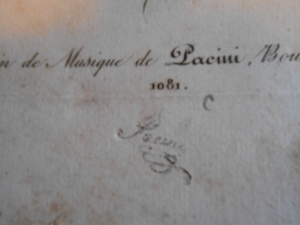
This shows the publishers hand stamp on the title page. Meyerbeer Il Crociato in Egitto Piano Forte no 17
I am not sure, but I believe that the edition I have may be the new edition with an added part of the score. The edition from Harvard may be an earlier edition. I sure would love to hear from anyone who can tell the difference or provide any additional information.

This is the binding that was probably done in the late 19th Century. Meyerbeer Il Crociato in Egitto Piano Forte no 17
The copy I have was done in a 1/4 red leather with gold letters, “IL CROGIATO IN EGITTO MEYERBEER” on the spine. Although the copy shows typical wear, it seems to be in very good condition for its age, perhaps even a litter better than the one Harvard digitized.. At one time there was a book plate (3″x2 5/8″) that was removed, leaving only a small half inch section of the original graphic remaining. Below the book plate there once was a strip of paper (1 1/8″ x 3/1/4″) that was also removed. )n the upper right of the title page are the numbers 1921 in pencil.
On the back of the title page in pencil is written the following:
M. 225.20
Allan A. Brown
Aug. 14, 1894
When I purchased the book I was told that it had come from a university in the North Shore of Boston.
On pages 193, 201, 204, and 205 there are light red pencil marks as if someone was trying to note the score for playing or flag the music for their research. Need to add pictures of this later.
Finally, my curiosity got the best of me and I called Harvard to ask about their edition. I figured that two copies of the same opera, that are this similar might be related. I left a message for Kerry Masteller at Harvard. When she called, I had a contractor in the archeological dig in my front yard (www.statlerprojects.wordpress.com), our collie (Ralph Waldolf Emerson) was trying to jump onto my desk, and I was late for a meeting. Something typical about the insanity. We talked briefly and she followed up with an email.
That email dated November 14, 2012 was as follows:
Mr. Gilfillen,
I’ve done some checking, and although I don’t have much information, here’s what I’m able to tell you about the copy of Meyerbeer’s Crociato in Egitto that you saw online (http://nrs.harvard.edu/urn-3:fhcl.loeb:4508152). The Harvard University Library received the score as part of the 1918 bequest of Harvard alumnus and collector Evert Jansen Wendell (1860-1917); I don’t know where he acquired it or when it was officially transferred to the Music Library’s collection.
Allen A. Brown (1835-1916) is responsible for the core of the Boston Public Library’s special collections in music; you can read more about his collection here: http://www.bpl.org/research/music/spmusic.htm#allen_music.
The stamp “Pacini” you’ve noticed on the title page of the two scores looks to me like a standard publisher’s/seller’s stamp; you can see the same stamp on the first page of this PDF from the International Harp Archives at BYU http://contentdm.lib.byu.edu/cdm/ref/collection/MusciScores/id/376 (I chose this score simply as the first example of another digitized Pacini score that I found). I’ve attached a short article about the publisher from the Grove Dictionary of Music and Musicians.
Best,
Kerry
Kerry Carwile Masteller
Reference and Digital Program Librarian
Eda Kuhn Loeb Music Library, Harvard University
Cambridge, MA 02138
617-495-2794
I hope when she reads this, she will understand how helpful and important she was in helping solve this mystery. it is not uncommon for me to find something and try to do some research. Sadly, I have come to the conclusion that only a rare person like Ms Masteller understands how important finding information like she sent me can be. She would be a great help to “The History Detectives” on PBS.
This is the link to the Allan A. Brown Collection at the Boston Public Library
http://www.bpl.org/research/music/spmusic.htm#allen_music.
This is a copy of the information on the Boston Public Library web site:
Allen A. Brown Music Collection
The heart of the Music Department’s holdings is the Allen A. Brown Music Collection, named for the donor who presented it to the Library in 1895. By the terms of the gift, the original collection is housed in a specially designated area, and the books and other materials included in it are restricted to use in the Music Reading Room. Mr. Brown made regular additions to his original gift of 6,990 volumes so that it had nearly tripled in size by his death in 1916. The collection continues to grow through purchases from trust funds, including the Allen A. Brown Fund, and now contains more than 40,000 books, scores, and manuscripts.
The Brown Collection reflects the broad musical interests and activities of a collector and serious amateur musician at the turn of the century. It is well rounded in the area of operas, oratorios, orchestral and chamber music as well as solo songs and catches and glees both in manuscript and published score format. One of the important aspects of the collection is the ephemera Mr. Brown collected and preserved. Reviews of performances, published interviews, biographical sketches, concert programs, etc. are pasted in many of the books and scores that he purchased as well as in the numerous scrapbooks which he compiled.
Years of heavy use and environmental conditions have taken their toll on the collection. As a result, certain parts of the Collection have had to be restricted to persons working on serious research projects and graduate students working on their theses or dissertations. Prospective users should be prepared to present letters of introductions and proper credentials. For further information, please contact the Music Department.
After receiving the email from Ms Masteller I called the Boston Public Library. A serious concern was that this volume cold have been improperly removed from the stacks. At the time several months ago I was able to find a copy of the bookplate from the Boston Public Library that matched the small section in the bookplate I found in the front of the book. This verified to me that at one time that this copy had been at the Boston Public Library.
So with that in mind, I called the Boston Public Library and talked to a gentleman. There was some confusion and then I was able to give him the information penciled behind the title sheet
M. 225.20
Allan A. Brown
Aug. 14, 1894
He indicated that the numbers were call numbers to the Brown Collection. He put me on hold and went back to the stacks and verified that this piece was from their core collection. OK, so was it stolen and/or how did it get into the public domain. I do not handle stolen items and would have felt compelled to have returned it had it been stolen. However, he informed me that there was a note in the catalogue probably from the 1930 that stated: “been officially removed by A. A. Meyer.”
This means that this piece was legally available on the open market for sale when I bought it from a dealer in good faith.
This started me on an internet search for who A. A. Meyer was and what he was doing with this opera score. At first I was on a complete wild goose chase. A.A.Meyer shows up on some land deals in court but nothing logical to music or someone who might have access to a book like this at the Boston Public Library.
Finally I found a reference, to an Alfred H. Meyer of Boston related to Musical compositions with a date of Sept 18, 1941.
This led to a reference for an Alfred H. Meyer, Instructor in Theory of Music, Boston University.
Then there was the 1939 CHRISTIAN SCIENCE MONITOR article “What Music Means to Ernest Bloch” by Alfred H. Meyer (http://www.uflib.ufl.edu/spec/belknap/composers/bloch.htm).
But why was Alfred allowed to take out a rare book like this one and keep it? Boston professor of music theory? Doesn’t sound like a rich patron who could just walk in and take something like this.
Then, his name was Meyer and the composer is Meyerbeer. Interesting connection that I am still not sure has a meaning.
I did keep seeing references to Alfred and the Boston Symphony.
Finally on the achieves for the Boston Symphony, the answer as to how he got his hands on this piece and his direct connection to the Boston Public Library became clear. On the web site for the Boston Symphony Orchestra, under Subscription years 1935-36 for the concert programs is an advertisement.
If you go to this link: http://archive.org/details/bostonsymphonyor3536bost
and plug into the search “Meyer” you should find a reference I have paraphrased here that states:
University Extension Lectures on the Boston Symphony Orchestra Programs were given in the 1935-1936 Season in the Lecture Hall of the Boston Public Library preceding concerts. The course was offered by the Division of University Extension, Massachusetts Department of Education, in co-operation with the Boston Public Library. Richard G. Appel of the Music Division of the Boston Public Library, and Alfred H. Meyer of the Boston University College of Music Oct. 10, 1935
So the director of the Music Division of the Boston Public Library, Mr. Appel, who was lecturing with the Music Professor Alfred H. Meyers legally permitted the book to be released from the collection. We may never know the specifics. Then in those days, a score like this had very little cash value on the secondary market.
From this, I could assume that sometime after Mr. Meyer passed on, this copy was given to a university in Boston’s North Shore. It was purchased at a library sale by Jane Fields of Boxford MA who ran a very wonderful small wholesale book store out of her home.
Then one Saturday, while making my rounds, I spotted this piece and bought it. Since then, I have taken this book with me form the States to Piran, Slovenia where I lived for several years and then back to the US where I am now in NC with this piece beside me as I write this.
So where does it go from here. My first answer is I do not know. Perhaps someone reading this will have an idea. At least the journey this Opera has taken has been documented. That was one of my goals when I created this web page. If you have thoughts, questions or ideas please let me know.
Since posting this in 2015, additional information continues to become available about this piece of music by Meyerbeer. A page on Wikipedia is now available at: https://en.wikipedia.org/wiki/Il_crociato_in_Egitto
If you want to listen to this there is now on YouTube the opera:
https://www.youtube.com/watch?v=VQ5FbAg4SNs
Statler Gilfillen
This is my professional site as an Architect
https://gilfillenarchitect.wordpress.com/
This is a site where I post research and stories and just interesting things
https://statlergil.wordpress.com/
revised June 2017
revised March 2018

